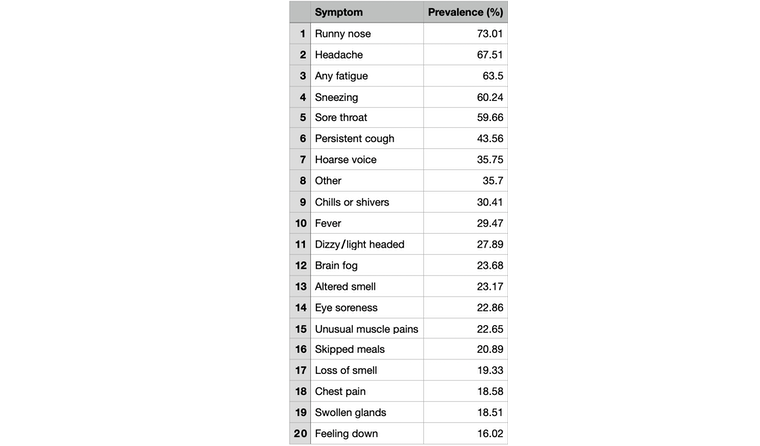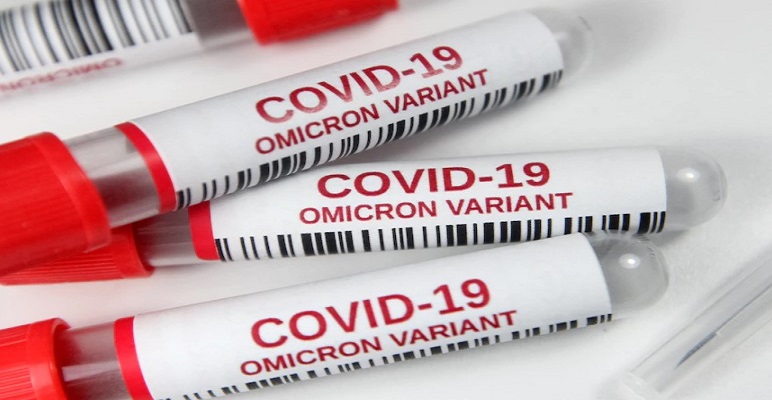For nearly two years, millions of individuals have been submitting daily health reports to the ZOE COVID Study, helping us track the epidemic as it spreads.
In particular, the 480 million reports submitted through the study application showed that as the virus develops, the symptoms it causes appear.
Symptoms of Omicron
In 2020, it soon became clear that the original and alpha versions of the Coronavirus caused three very common symptoms: cough, fever, and loss of smell, in addition to at least 20 other symptoms, including fatigue, headache, shortness of breath, muscle aches, and digestive problems, in addition to To more unusual phenomena such as skin rashes and “Covid tongue”.
When deltas appeared, we noticed a change in the most common symptoms.
Previous common symptoms, such as shortness of breath, fever, and loss of smell, fell to the bottom of the rankings. Cold-like symptoms, including a runny nose, sore throat, and persistent sneezing, are becoming more common, along with headaches and coughing, particularly in vaccinated people.
Omicron appears to be continuing the trend set by Delta. It causes symptoms very similar to the common cold, especially in vaccinated people, and less general systemic symptoms, such as nausea, muscle aches, diarrhea, and rashes.
We looked at health reports from people who reported having COVID in December when Omicron spread across the UK and compared it to data from early October when Delta was the dominant variant.
We then validated our findings from this comparison by also looking at data from a small group of collaborators who were told by the government that their PCR-positive results were suspected or confirmed by Omicron.
Our analysis showed no significant differences in the overall appearance of delta and omicron symptoms, with the top five symptoms in both periods being a runny nose, headache, fatigue, sneezing, and sore throat. But when it comes to the general prevalence of symptoms, there are some distinct differences.

For example, loss of smell (loss of smell or taste) was in the top 10 in October but has fallen to 17. What was once a leading indicator of COVID is now seen in only about one in five people giving Positive results. According to our data, less than a third of people (29%) will ever have a fever, which is also less common than we’ve seen in the past.
Importantly, we found that only half of people with COVID had any of the three classic symptoms of fever, cough, or loss of smell.
How bad is Omicron?
This new type is much more contagious than previous variants, causing an increase in cases in the UK and other countries. And while it’s not yet clear whether we’ll face a tidal wave of hospitalization for the illness, it’s important to remember that while Omicron and Delta may feel cold for many of us, they can still cause death or long-term symptoms of Omicron. To disrupt daily life, especially for people who have not been vaccinate or who are immunocompromise.
So far we have seen the majority of cases in young people, but now we are also seeing an increase in cases in the older age groups, while the overall rate of infection remains very high.
The recent increase in positive cases in people over the age of 75 is alarming, but we hope that higher levels of vaccination in older and more vulnerable groups will continue to result in milder symptoms of Omicron and fewer hospital admissions. The main problem at Omicron is the wave of sick leave it causes for key health personnel.
Is it Omicron or a cold?
Data from the ZOE COVID Study app tells us that symptoms caused by the current variants of COVID are very similar to those of the common cold. This means that it is not possible to know for sure what you have based on symptoms alone.
When the rate of COVID infection is high, a new sore throat, runny nose, or unusual tiredness should be treated as COVID until testing.
As the contributors to the ZOE COVID Study app log all the daily symptoms they experience, as well as their COVID test results, we can also track the spread of non-COVID colds. Just three months ago, 1 in 12 people tested positive for new respiratory symptoms [in the UK] with the COVID virus. However, using Omicron, about 50% of today’s “new colds” are actually COVID.
So if you or a loved one is not feeling well, there is a good chance of contracting coronavirus, especially if you snore and sneeze a lot.
You should stay at home and get test to be sure.
Finally, regardless of government guidelines, whether or not you have COVID, it’s best to stay home if you feel sick with strange or cold-like symptoms, avoid contact lenses and wear a mask if you go out, to avoid spreading your germs. Others who may be at greater risk.
Originally published in The Conversation. Read the original article.
